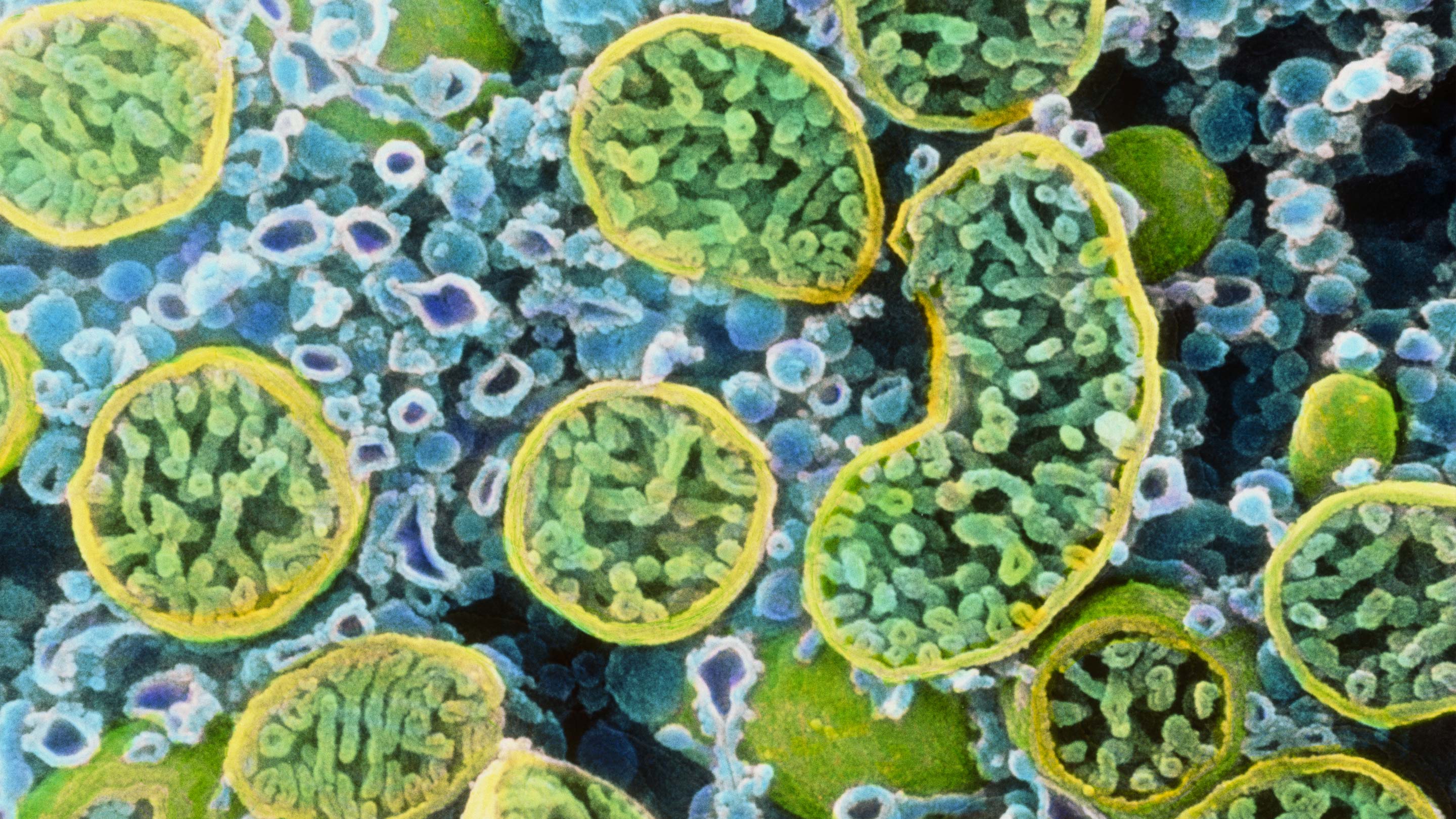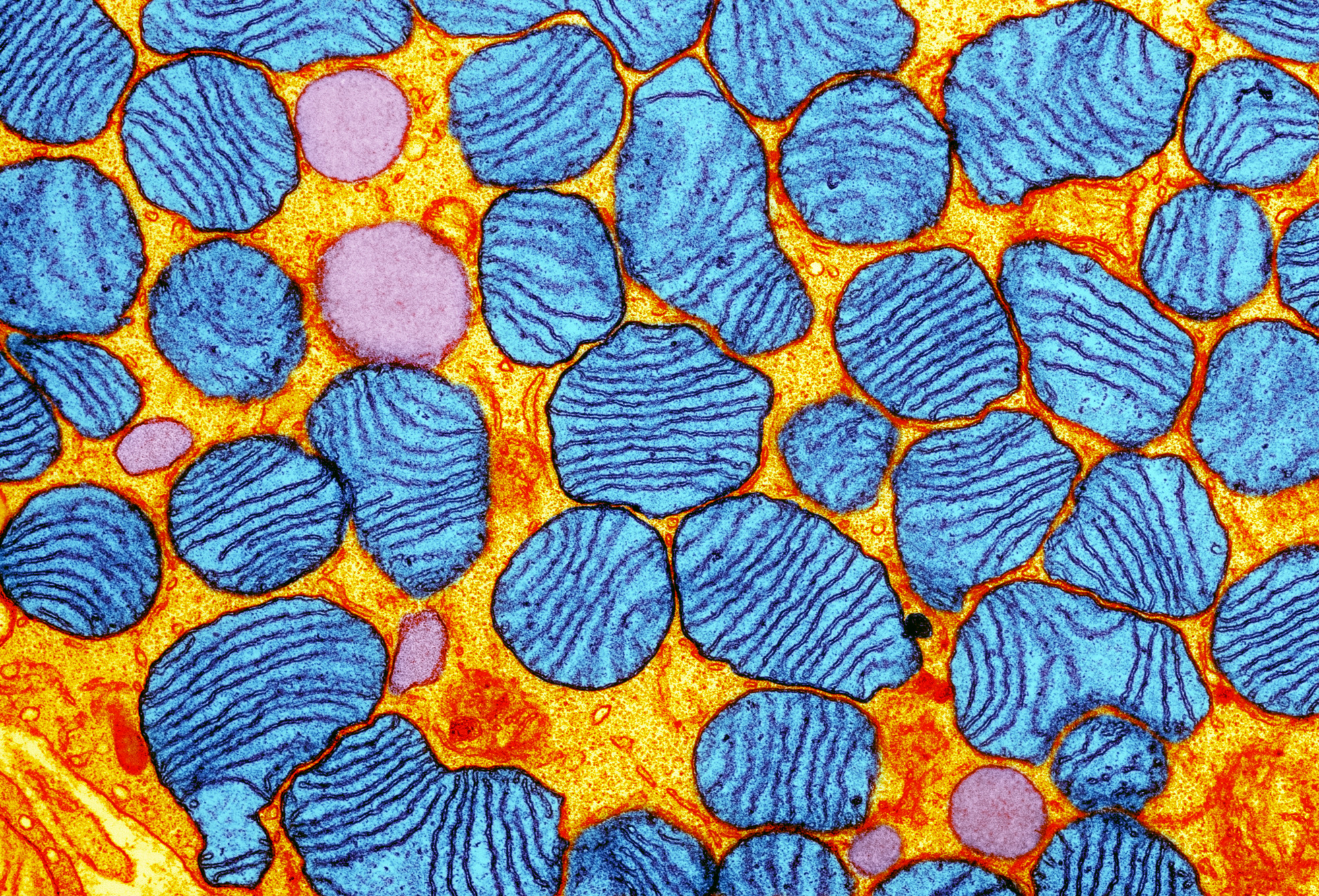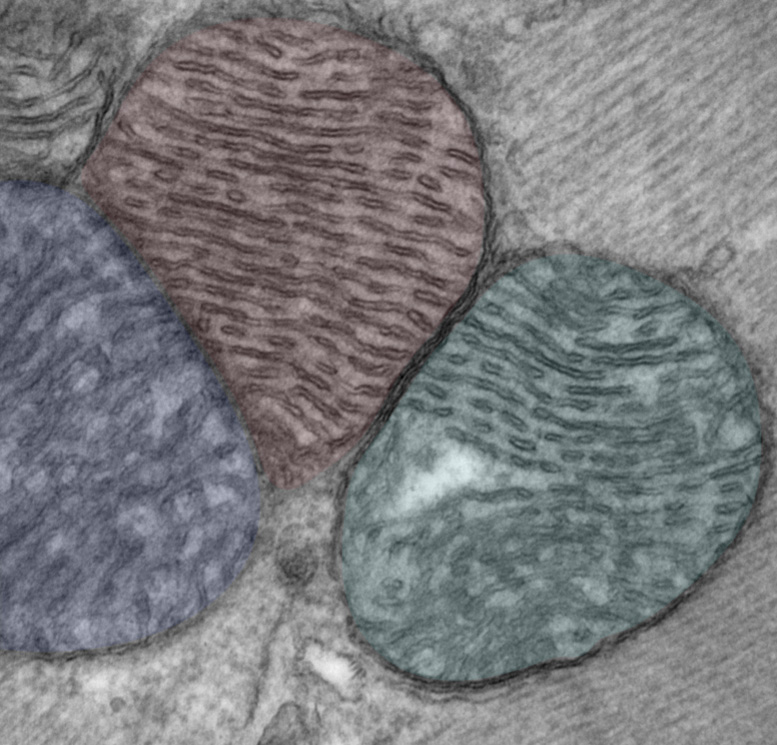‘Social’ Mitochondria, Whispering Between Cells, Influence Health

In this false-colored cross-section through an ovarian cell, the mitochondria appear as yellow-edged organelles. Evidence suggests that mitochondria send signals to one another and operate in coordinated networks.
P.M. Motta, S. Makabe & T. Naguro/Science Source
Introduction
During his doctoral research on the ties between aging and mitochondria, Martin Picard frequently saw micrographs of those energy-producing organelles. Yet it wasn’t until fairly late in his graduate work that he first watched sped-up video of mitochondria moving inside live human cells, and the sight came as a revelation.
Tagged with fluorescent dye, the mitochondria were neon squiggles crawling through the soupy interior of the cells — stretching and contracting, fusing together and splitting up again, sidling up to one another and parting ways. Their apparent eagerness to network reminded Picard of the social exchanges among complex creatures like fish and ants. “They just look a little more primitive,” he said.
Now, after years of work in his own laboratory and others that has underscored the importance of those dynamic mitochondrial interactions, he is pressing that comparison more literally. Recently, in Neuroscience & Biobehavioral Reviews, Picard, a mitochondrial psychobiologist at Columbia University, and the neuroscientist Carmen Sandi of the Swiss Federal Institute of Technology Lausanne argued that mitochondria need to be understood as the first known social organelles.
As evidence, they cite a long line of discoveries showing that mitochondria are surprisingly interdependent and that their functions go far beyond their familiar role as cellular powerhouses: Mitochondria also make certain types of hormones, help drive immune responses, and shape the developmental fate of cells. To these diverse ends, like ants in a colony, mitochondria divide up tasks, form groups, synchronize activities and respond to both their environment and each other. A “social lens,” Picard and Sandi wrote, may be essential not only for explaining the behavior of individual mitochondria, but for revealing the mitochondrial collectives that influence human health.
Despite some reservations about the label “social,” other scientists generally agree that understanding the bustling signaling networks that mitochondria establish within and between cells could help unlock secrets about health and disease. “If we understand how the mitochondria are acting together, and we learn how to manipulate it,” said James Eberwine, a molecular neurobiologist at the University of Pennsylvania, “we’re going to gain so much more insight into biology.”
The Deep Roots of Sociality
To understand how organelles like mitochondria could be social, it helps to remember that sociality is a phenomenon with deep evolutionary roots. Bacteria are among the simplest of organisms, yet they exhibit remarkable community behaviors; they can act independently or together, communicating and cooperating to form complex structures.
During the heyday of single-celled life about 2 billion years ago, the forerunners of mitochondria were bacteria that found a niche inside larger cells, providing them with energy. This symbiosis was so beneficial that it likely powered the evolution of multicellular organisms. As a relic of their bacterial origins, mitochondria still carry their own small genome, separate from the cellular genes in the nucleus.
But although all our mitochondria are inherited from our mother’s egg, individual mitochondria differ at the genomic level. Some mitochondria harbor a dozen copies of the genome, while others have only one or even none at all. The genomes themselves also often carry subtle genetic variations. Although some mutations may cause mitochondria to malfunction and be culled, Eberwine speculates that in general their genetic diversity is a good thing that enables different behaviors or functions.
Even beyond the genetic level, diversification is key to the role of mitochondria. During embryonic development, as the cells divide and differentiate, their mitochondria unfold into a remarkable range of designs and functions. While all mitochondria have the ability to generate energy in the form of adenosine triphosphate (ATP), they take on other specialties in different tissues. In the adrenal cortex, for instance, they make the hormone cortisol; in the liver they help to detoxify ammonia.

In this colored electron micrograph, mitochondria (blue) float within the cytoplasm of an adipocyte (fat cell).
CNRI/Science Source
Yet as much as mitochondria can look like individual entities, they also intermingle a lot throughout their life cycle. Scientists have known for decades that mitochondria fuse — merging membranes into single, branching structures — and cleave back into individuals by fission. These two processes are in constant flux, depending on the state and needs of the cell, said Jodi Nunnari of the University of California, Davis, whose lab has pioneered research on these dynamics.
These mitochondrial rendezvous serve multiple purposes, at least one of which seems to be cooperative. Single mitochondria that lack a genome or have a dysfunctional one can be “rescued” by fusing with healthy neighbors. The connected structures create a conduit for sharing chemical signals and proteins, and fusion might help allot proteins more equally among mitochondria, Nunnari said. But fusion doesn’t mix everything. “That’s important too — to maintain a little bit of individuality even when you’re within a network,” she said.
Electromagnetic Signals?
It’s becoming increasingly clear that mitochondria have ways of interacting other than fusing. They can also shuttle substances to each other through less committed “kiss and run” events in which they briefly join membranes, or through long protrusions called nanotunnels, which are found in some cells where mitochondria are less mobile.
As a postdoc in Douglas Wallace’s lab at the Children’s Hospital of Philadelphia in 2015, Picard and his colleagues discovered another curious mode of communication. In mammalian cells, at the sites where the mitochondria touch, they can form connections across which they align their cristae, the dark inner membrane folds that resemble grill marks in micrographs. For that kind of alignment to occur, the mitochondria must be conveying signals to one another about the position of their cristae and realigning them accordingly.

Mitochondria have shelflike internal membrane folds called cristae. Picard’s research group observed that when mitochondria touch, their cristae can line up on either side of the membrane.
Courtesy of Martin Picard; source: doi.org/10.1038/ncomms7259
Picard said that his best guess “is that there’s some kind of electromagnetic signal that’s being transferred.” At those inner membrane folds, molecules derived from food are used to pump charged ions across the membrane, creating a membrane potential of around 180 millivolts. The resulting force of ions rushing back across the membrane to equalize the difference is used to generate ATP. It also generates an electrical current and an accompanying magnetic field. If an electromagnetic signal is indeed being relayed between mitochondria, that signal would be propagating faster than the chemical signaling that occurs between the organelles. Whether that additional speed has functional significance isn’t yet known.
Researchers have probably not exhausted the range of interactions to be discovered. “We’re only at the beginning of trying to understand how the mitochondria communicate with each other,” said Brian O’Rourke, a cardiac physiologist at Johns Hopkins Medicine.
Another mystery surrounds precisely what all that communication is doing. Natalie Porat-Shliom, a cell biologist at the National Cancer Institute, suggests that one broad answer is that these social behaviors improve the efficiency of the whole organism. “The sense is that these responses are all tuned towards optimizing metabolism, optimizing function,” she said.
Pros and Cons of Synchronization
In some cases, for example, the mitochondrial chatter may synchronize energy production across cells that work together. Some years ago, Porat-Shliom and her colleagues were studying the acinar cells of the salivary glands, which act in concert to secrete saliva. Peering into the salivary gland cells of anesthetized rats, the team noticed that the synchronization of the acinar cells extended to their mitochondria: In many cases, the membrane potentials of mitochondria were rising and falling together about every 12 seconds, even when the cells weren’t secreting.
Porat-Shliom thinks that the mitochondria relay short-lived molecules to one another to couple oscillations across cells. That could help coordinate bursts of energy for secreting saliva when prompted — “to have all the cells respond at the same time, at the right magnitude,” she said.
Other groups have spotted similar synchronized oscillations — sometimes called flashes — in other cell types. But the phenomenon isn’t universal, Porat-Shliom added: Some cells, such as those in the liver, don’t synchronize their metabolism in the same way, perhaps because they perform different functions.
Indeed, synchronization might not always be a good thing, O’Rourke noted. For years, his lab has studied coupled oscillations among the mitochondria that power the contractions of cardiomyocyte (heart muscle) cells. When he and his colleagues stimulated small patches of mitochondria in isolated cardiomyocytes with a laser, most of the mitochondria across the gigantic cells eventually started to oscillate in tandem.
O’Rourke sees this coupling as a stress response with potentially dangerous consequences. His team’s results suggest that synchronized activity can sometimes suppress the cells’ contractions, impairing the transmission of electrical signals from one heart cell to the next and disrupting coordinated responses in the heart. When they looked at animal heart tissue, they saw that coupled oscillations could contribute to the cardiac arrhythmias that can occur when the heart is recovering from an interruption in its blood supply. Unlike in the salivary gland cells, pulsed generation of ATP doesn’t make sense in the heart, O’Rourke said, because the organ has a constant demand for energy, both during and between contractions.
In general, there’s a growing appreciation for the diversity of mitochondria within cells, but also for their tendency toward collective behavior. Mitochondria often gather in groups or form distinct populations that behave differently and “can be doing different things at the same time,” noted Nuno Raimundo, a cell biologist at the University of Göttingen in Germany.
Neuroscientists, for example, have often remarked that mitochondria take on distinctive appearances in different parts of the neuronal landscape. In the center of some types of neurons, the mitochondria can resemble rugby balls or tubes; in the spindly dendrites that receive incoming signals from other neurons, the mitochondria form long, branched networks; at the sites of outgoing signals in axons, the mitochondria look more like tennis balls. Those shapes, recent research suggests, allow the organelles to take up different amounts of calcium, in keeping with the varying needs for the ion throughout the cell.
Even the Analogy Is Powerful
To Picard and Sandi, the repeatedly documented instances of the diversity, interactivity and apparent cooperativity of the organelles point to the existence of mitochondrial social networks in living things. And these networks might extend beyond the confines of cells: Cortisol made by mitochondria in the adrenal gland can influence mitochondria elsewhere, creating a long-distance means of communicating stress, Sandi added.
For Picard, who as a mitochondrial psychobiologist studies how psychological stress makes itself felt at the level of mitochondria — and what the physiological consequences of that can be — the sociability of the organelles is one component of the wider interconnectedness of life. In essence, sociality begets sociality begets sociality: The sociability of mitochondria facilitates the cooperation of cells, which in turn allows the formation of organs that depend on one another and the creation of complex organisms. The social nature of animals is an extension of the sociality seen at lower rungs of the ladder, Picard said.
But even some scientists who are enthusiastic about the importance of studying mitochondrial interactions still hesitate to label them as social. “There is a power in making the analogy,” Nunnari said, “but … I try not to anthropomorphize mitochondria.”
Part of the problem is that descriptions like “social” or “cooperative” imply a degree of agency that feels inappropriate for organelles. “It’s not that they ‘want’ to be a group or they don’t,” Raimundo said. “It’s just how they were programmed to behave.”
Yet he also suggested that viewing mitochondria as participants in something like social networks is a useful perspective. Scientists have typically taken reductionist approaches to the study of mitochondria — dissecting out the individual genes and proteins underpinning their biology. That research is crucial to understanding the nuts and bolts of mitochondrial interactions, Raimundo said, but it should be augmented to address the interactions themselves. Doing so may sometimes require treating mitochondria as entities that process information independently while acting on it jointly.
Clues to Health and Disease
Raimundo said this networked view of mitochondria may also be broadly important to the study of signaling between different types of organelles. It’s been known for decades that mitochondria have an intimate relationship with the nucleus, where most of the genes for mitochondrial proteins reside. Yet it’s becoming apparent that mitochondria also have numerous interactions with other organelles.
Studies of networks of mitochondria are already yielding insights into some diseases. For instance, some scientists suspect that defective energy metabolism plays a role in Parkinson’s disease, but so far, no clear difference has been found between the neuronal mitochondria of patients and healthy people. But a research team led by Feng He of the Luxembourg Institute of Health recently directed a computer to crunch through 700 gigabytes’ worth of microscopy videos of gut neurons from Parkinson’s disease patients. The system identified nearly 20 features that mathematically characterized the mitochondrial networks in their cells in terms of the organelles’ density, proximity to one another, and interactions. The study, which examined only a small number of patients, found that the features could collectively differentiate patients from healthy people. To He, it seems that mitochondrial networks in Parkinson’s disease might be less efficient, and that this inefficiency could contribute to the disease. By capturing layers of biology that more reductionist approaches tend to miss, such network studies could “reshape [our understanding] of different cell types in our body,” he said.
Eventually, network approaches could yield clues about new treatments, Picard said. But he already has ideas about the value of improving mitochondrial communication. In one 2013 study, he and his colleagues gave mice a running wheel for three hours, and then took a close look at the mitochondria in their lower calf muscles. Where the organelles brushed against each other, they formed new connections — the same kind that aligns their cristae. This could mean that part of what makes exercise healthy is that it promotes communication between mitochondria. “It makes them more social,” Picard said.



